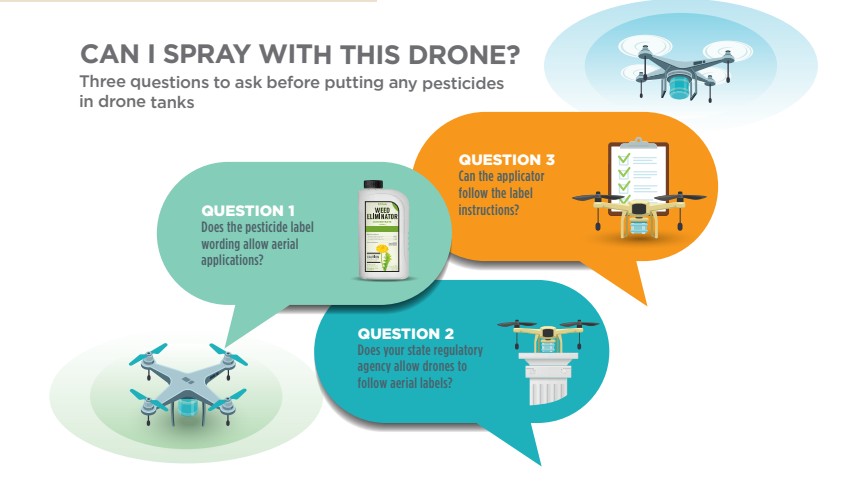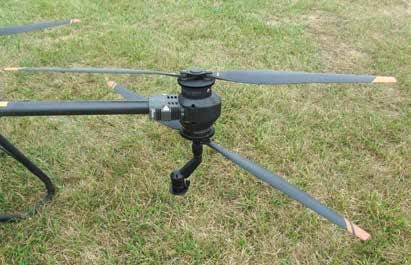10.Pesticide Labels — A Quandary for Clear Guidance
RESOURCES - PUBLICATIONS
The Evolution of Spray Drones, Their Capabilities and Challenges for Pesticide Applications
10. Pesticide Labels — A Quandary for Clear Guidance
There is a high degree of interpretation of what label instructions say when it comes to using drones for spraying pesticides. Currently, specific information about the carrier volumes, application heights, nozzle types, and droplet sizes that are typical of drone applications are not incorporated in the aerial application sections on product labels. However, we do expect that information for drone use will begin to appear on pesticide labels as soon as reputable sources adequately research the issue and regulatory agencies review further application requirements or considerations that need to be provided.
Can I Spray any Pesticide Using a Drone
To answer the general question of whether you can use any pesticide using a spray drone, you should ask yourself three specific questions.
Question 1: Does the Pesticide Label Prohibit Aerial Equipment?
Many pesticides work well when sprayed with drones. No one could have foreseen that drones would be applying products on golf courses, greenhouses, ponds, tree plantations, and nurseries. Regardless, if a pesticide label has language that reads “Do not apply this product using aerial equipment,” then the answer to this one question is clear: You can’t legally apply this product with a drone.
If a product label prohibits drone applications, then drone operators take full responsibility if it fails or causes problems whether on- or off-site. Manufacturers have no liability when applicators use their products if labels prohibit that application method. There could also be repercussions from regulatory agencies for using the product off-label.
Warning: Regulations and Interpretations Are Changing
In this document, we provided what we believe is true as we were writing it. It is always important to check with FAA websites and your state pesticide regulatory agency for up-to-date regulations and policies.
CAN I SPRAY WITH THIS DRONE?

Three questions to ask before putting any pesticides in drone tanks
QUESTION 1 Does the pesticide label wording allow aerial applications?
QUESTION 2 Does your state regulatory agency allow drones to follow aerial labels?
QUESTION 3 Can the applicator follow the label instructions?
Instructions on product labels may be different from one product to the next even though the chemicals contained in those products are similar or almost identical. For example, some generic 2,4-D formulations typically used in burndown herbicide applications are labeled for aerial application. However, some 2,4-D formulations, which have been developed to spray post-emergence in 2,4-D-resistant soybeans, are not approved for aerial equipment. Although both pesticides are 2,4-D, they cannot be treated the same with a drone.
You must read and follow label instructions for the specific pesticide you are using. Do not make assumptions that it is OK to use drones to spray this one pesticide because you previously used a similar product by different manufacturer with the same active ingredient that allowed using drones.
Question 2: Does the State Regulatory Agency Allow Drones to Follow Aerial Labels?
The U.S. EPA currently allows each state regulatory agency to determine whether drones can operate under instructions for aerial applications. You will need to ask your state pesticide regulatory agency if they allow drones to apply pesticides using the instructions provided on product labels for aerial applications. You also should ask what state-specific pesticide certifications they require for you to use drones to apply pesticides. These certifications will vary from state to state. Not all states observe reciprocity, so applying across state lines may require multiple examinations and certifications.
Question 3: Can the Drone Follow Aerial Application Instructions?
If a pesticide product has an aerial application section, then a drone (if your state allows) can apply it by following all requirements listed under the label’s aerial section. You are required to follow the minimum or recommended application rates per acre, carrier volume, and other criteria listed on the product label. If you cannot follow some of the aerial application label requirements because of unique application parameters used with drones, then you cannot legally apply the pesticide with a drone.
Only following part of the label and ignoring requirements on other sections can create efficacy problems, increase the chance of pesticide resistance evolving, and allow illegal residues to remain on harvested commodities. It also violates one of the key statements on all labels:
“It is a violation of federal law to use a product inconsistent with its labeling.”
How you interpret a label depends on how the instructions are worded. A label’s recommended carrier volume is often a make-or-break deal for legally using spray drones. Remember, drones use significantly less carrier volume of water per acre than ground rig applications. Some pesticide labels may require 10 to 20 gallons of volume per acre for ground rigs and 5 gallons per acre aerially. Spray carrier volume rates exceeding 2 or 5 gallons per acre become difficult for some drones to accomplish because these rates severely limit drone efficiency. At that point applications can become cost prohibitive.
How would you interpret the following label direction about the application rate?
“Do not use less than 10 gallons of spray solution per acre.”
There is no flexibility in this language. The label clearly states that you must spray this solution at a rate of 10 gallons or more per acre, which means you would be off label if you use a drone (or any other application method) to apply less.
Other labels are written with some flexibility. For example, two labels provided the following information:
- Use the recommended rates in 3 to 25 gallons and
- Minimum spray volume per acre is 2 gallons
Such language gets you into the lower range of volumes that drones can take advantage of. It also means that the manufacturer has done the research to support that the amount of carrier they recommend on their label will work and that doing so adheres to other regulatory safety conditions such as crop residues.
DRONE FACT
You can increase drone spray coverage by optimizing swath speeds, flight heights, adjuvants, spray tips, and spray volumes.
Regardless of what spray equipment they use, the goal of sprayer operators is to adequately cover the target with the pesticide while minimizing spray drift.
There are two common ways to increase coverage on the target:
- Increase the gallons per acre application rate — perhaps by using nozzles that have higher flow rate capacities (gallons per minute)
- Reduce droplet size
Relatively smaller spray droplets are highly susceptible to spray drift. To minimize this risk, pesticide manufacturers have been including droplet size recommendations on labels (for example, ASABE Droplet Category). Some labels may even recommend not using fine spray droplets to avoid spray drift.
Unfortunately, to achieve maximum coverage with low application rates of drones, most drone operators apply their products using nozzles that produce smaller droplets. However, some current research indicates that larger droplet sizes do not have the same coverage penalty from drone applications as they do from ground-based applications, so larger droplet sizes could be used for both drift mitigation and coverage. Remember, the label is the law. Therefore, you should read the label carefully to determine if there are specific requirements on the label related to droplet sizes, nozzle types, and spray pressures when using the specific nozzles.
Manufacturers commonly equip spray drones with standard nozzle bodies, so applicators can select which spray tips fit their specific needs for their intended applications and the pesticide requirements. Alternatively, spray drones may come with rotary atomizer nozzles that applicators can adjust to deliver a range of spray droplet sizes (photos to right). These “spinner” nozzles are similar to the controlled droplet applicator (CDA) nozzles that were popular for ground applications in the 1980s, but lost favor due to the complexity of the system being driven by hydraulic motors. Current atomizer nozzles on drones use electric motors.
Rotary atomizers provide some value because applicators may not have to change spray tips to adjust the spray droplet sizes. However, additional electric motors add weight to drones, which can drain batteries faster.
Rotary atomizers also have the advantage that they don’t clog like hydraulic nozzles can. You can spray a thick tank mix with rotary atomizers, which often is not possible with standard hydraulic nozzles fitted for drones. Rotary atomizers are not without challenges, because the spray quality can be compromised if the gallons per acre and travel speed are set higher than the intended nozzle capacities. Furthermore, adding spray adjuvants may alter the performance of rotary atomizers and impact droplet sizes from what is indicated on controller displays.

